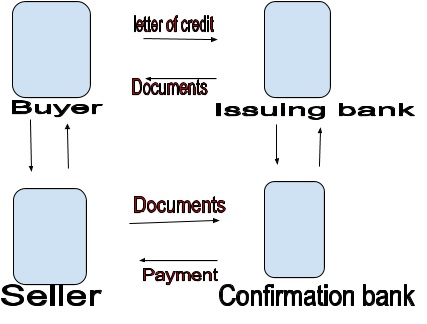In this article, Kunal Ahuja of Vivekananda Institute of Professional Studies discusses how Letters of Credit Work.
Limitations to international trade and role of inland letter of credit
- With the intervention of globalisation and international trade into the import-export industry, it is not possible for the parties to meet on regular basis and do business by traditional methods of payment with which it becomes difficult for the parties to present their creditworthiness and to develop a relationship of trust amongst each other.
- When an international business is taking place between the parties the recourse of payment becomes difficult due to the difference in their currencies which again complicates the process of payment and every party thinks twice before getting involved in such commercial transactions.
- It is an instrument which allows the buyer and seller from different nations come together or without coming together and pursue a business of their interest without being suspicious or risk factor about the trust amongst each other which used to be a major reason in hindering the international trade.
To overcome the above obstacles in the way of international trade and to do business at global level the letter of credit plays a significant role and makes the international trade more efficient as well as credit worthy for parties.
- Inland letter of credit is a document of commitment to make the payment by the buyer’s bank to the seller’s bank rather than from the buyer to the seller directly. It is a term which is commonly used in the transactions which are of trading nature.
- Inland letter of credit is a modern recourse of payment applied to reduce the risk of losing the funds or not getting the payment on time or not even receiving the payment at all as it transfers the liability of making the payments from the buyer to the bank who takes the guarantee to make the payment in case the seller defaults.
Understanding Letter Of Credit
- Commitment document – Letter of credit is an instrument of commitment issued by the buyer’s bank on the request of the buyer and handed over to the seller or seller’s bank to secure his payment once the terms agreed by the buyer and seller has been fulfilled by both the parties. It is a monetary document which entitles the seller to get his payment from the bank after submitting the required documents to the bank to prove that the terms of the deal have been fulfilled by the seller and now he has the right to get the payment.
- Banks as intermediaries – As per the contract between the buyer and seller the buyer once receives the goods as promised by the seller, then buyer is liable to pay the amount to the seller in lieu of deal entered by both of them. It is issued by the buyer’s bank i.e. issuing bank as a payer of the amount on behalf of the buyer and seller receives the payment from his bank i.e. confirmation bank to which the letter of credit is presented and is obliged to honour the payment to the seller. Here transaction including a letter of credit is settled through the banks rather than directly between buyer and seller.
- Secured payment – In an international business or trade between the buyer or importer and seller or exporter there is high probability of fraud and exporter does not receive the payment on time or payment at all. To curb this risk the letter of credit is issued in which bank undertakes the guarantee to make the payment to the exporter and his efforts to do a business doesn’t go in vain. Risk factor in normal course of transaction is very high which almost vanishes with the issue of letter of credit where the payment is made by the banks and letter of credit. Involvement of bank as a neutral party through letter of credit allows the seller to trust the contract and buyer which helps him to with which get his payment on time from the bank.
- Business in any currency – Earlier when any international business used to take place the funds transfer and currency change was a bigger task but with the letter of credit this hurdle has been pulled down and letter of credit can be honoured in any country as per their currency rates as the payment is made at the place where the seller resides or has a place of business.
Essential elements of letter of credit
- Undertaking by a bank for the payment
- On behalf of the buyer
- Payment to be made to the seller
- Of certain amount
- Payment to be made only after submission of certain documents by the seller
- Within a particular time period
- Bank shall verify the compliance with the terms and conditions of the contract by the seller.
How does a letter of credit works
There are several steps which are followed while issuing a letter of credit and using it as a mode of the payment:-
- Contract – The parties i.e. the buyer and seller enter into a contract and negotiate upon the terms of the contract. This contract determines the nature of the business and mode of payment by the buyer to the seller if the buyer has received the goods for which both parties entered into the contract. Normally the letter of credit is issued in international trade or between importer and exporter.
- Buyer approaches for issuance of letter of credit – After the contract the buyer approaches his bank, which is also called the issuing bank, to apply for issuance of the letter of credit in the favour of seller and seller’s bank i.e. confirmation bank according to which the issuing bank undertakes the responsibility to pay to the seller on behalf of the buyer.
- Issue of letter of credit – It is issued by the issuing bank in the name of the buyer which is further issued to the seller as the consideration.
- Issued to the seller – Issuing bank issues the letter of credit to seller either by its branch or any correspondent bank in the seller’s country.
- Letter of credit when honoured – Letter of credit is issued to the seller and seller is entitled to the payment from the confirmation bank only on the submission of the required documents which are necessarily submitted to prove that the terms of the contract have been fulfilled by the seller, the documents can be any invoice, bill of lading, promissory note or any receipt etc.
- Transfer of document – The prerequisite documents are submitted to the confirmation bank and which are the later on forwarded to the issuing bank and the buyer gets the document after the payment made to the issuing bank by the buyer. Finally, the documents are transferred to the buyer only when he makes the payment to the bank and the buyer can use the documents to procure the goods.
Types of Letter of Credit
- REVOCABLE CREDIT LETTER OF CREDIT – This is the letter of credit in which the issuing bank or buyer can change the terms of the contract without the consent of the seller.
- IRREVOCABLE CREDIT LETTER OF CREDIT – This is the letter of credit in which neither the issuing bank or buyer can make changes to it unless consented by the seller.
LIMITATIONS
Although letter of credit has uplifted the international trade and business, apart from its positive interventions letter of credit also lacks in its efficacy in various strata.
- Quality of goods not taken care of – With the issue of letter of credit banks are only responsible to check the documents and fulfillment of terms of the contract based upon what bank releases the payment but quality of the goods is not verified in this state. If the quality of the goods is not upto the mark buyer has to suffer as he cannot stop the payment.
- More expensive – Letter of credit involves the charges which are paid to the bank as well which makes this mode of payment more expensive.
- Complex – Issuance of letter of credit functions with certain degree of complexities the more rules and regulations to be followed by the parties as well as their banks which makes this recourse a complex one.
- Foreign currency – Letter of credit allows the seller to receive the payment in its territory and in case of international trade factors like difference in currencies and currency fluctuations adds more risk in this.
- Default of bank – The letter of credit transfer the creditworthiness of buyer to the bank, if bank defaults in making the payment then the risk on the seller’s payment still exists.
- Specific time period – Letter of credit is issued with the time limit specified in it and if the letter of credit is not presented within that certain period it gets lapsed. The documents submission has to be done within that period of time only otherwise the time to receive the payment and make use of letter of credit gets expired due to which a new process has to be followed and again adds to the business cost.
 Serato DJ Crack 2025Serato DJ PRO Crack
Serato DJ Crack 2025Serato DJ PRO Crack










 Allow notifications
Allow notifications




I definitely feel that letter of credit is a good way of maintaining trade relationship by exporter and importer. As it involves guarantee by a bank the exporter can be rest assured that the payment will come into his bank account. More importantly L C prevents unaccounted money from being transferred.